Time
|
Event
|
|
1857 |
Jean-Marie Le Bris,
a French sea caption, tests a glider modeled after an albatross. This "artificial
bird" makes one short successful glide, but on the second glide it crashes and Le Bris breaks
his leg. Felix Du Temple
and his brother Louis, France, fly a model monoplane whose
propellers are driven by a clockwork spring and later, a
small steam engine. It takes off under its own power, flies
a short distance, and glides to a safe landing. It is the
first successful flight of a powered aircraft.
|
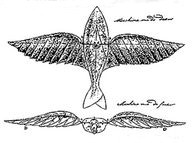
A top and rear view of Le Bris' first glider. Although the
wings were bird-like, the fuselage was decidedly
fish-shaped.
|
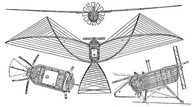
The patent drawings of Du Temple's 1857 model
airplane. Note that this is a "tractor" airplane, with the propeller at
the front pulling the aircraft. The success of this model was
the beginning of the standard tractor design tradition. |
|
1863 |
Jules Verne publishes
Five Weeks in a Balloon, describing an aerial trip
across Africa filled with danger and adventure. His first
novel launches both the science-fiction genre in literature
and Verne's career as one of the most popular authors on the
planet. This and many of his future books include
captivating feats of lighter-than-air and heavier-than-air
transportation. More important, they encourage a generation
of future scientists and engineers to consider the
possibilities of aviation.
|
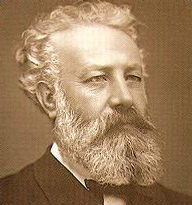
Jules Verne.
|
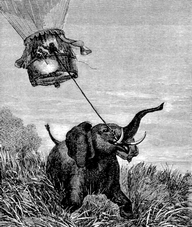
An illustration from Verne's
Cinq Semaines en Ballon.
|
|
1864 |
Count Ferdinand
d’Esterno, France, publishes the first scientific observations of the effects of the
wind on a wing in his pamphlet Du Vol des Oiseaux.
The paper also distiguishes between flapping and soaring
flight, and notes that only the larger, heavier birds soar.
The Count considers this fortunate: "...the odds are not
stacked against humans doing the same thing in a fair wind."
He suggests that soaring could be a wise and necessary step
on the path to manned flight. Siegfried Marcus
builds an internal combustion
engine with a carburetor (that he calls a "vaporisater")
and an electrical ignition system that uses a primitive
magneto to generate a spark.
|
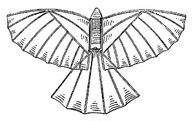
d'Esterno's "soaring machine" was a cross
between a fixed-wing aircraft and an ornithopter. The fronts
of the wings were fixed, the trailing edges flapped.
|
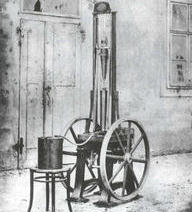
Marcus' engine was later mounted on a wagon to produce the first
automobile with an internal combustion engine.
|
|
1866 |
The
Royal Aeronautical
Society is founded in England.
Francis Herbert Wenham, England addresses the
first meeting of the Aeronautical Society. His speech, titled Aerial
Locomotion, is another milestone in aeronautics. He builds
upon d'Estern's suggestions and proposes that
aspiring pilots should practice first in gliders before trying to fly powered aircraft.
His own multiple-wing gliders have little success.
|
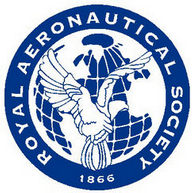
The logo of the RAS.
|
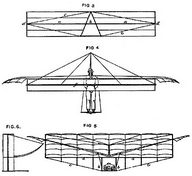
Some of Wenham's glider designs.
|
|
1867 |
April 16 —
Wilbur Wright is born in Millville, Indiana to Milton
and Susan Wright. Milton is a "circuit preacher" for the
Church of the United Brethren and will eventually lead his
own sect of that faith. When later asked what he
remembered about Wilbur's birth, Milton commented on the
enormous size of his head.
He also recalled that Wilbur had an enormous capacity for
mischief. |
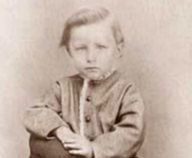
By the time this photo was taken, Wilbur's body seems to
have caught up with his head.
|
|
|
1868 |
Jean-Marie Le Bris tests an improved version of his
glider, making several unmanned glides before it crashes.
The Great Aeronautical
Exhibition, the first exhibition of flying machines,
takes place at the Crystal Palace in London, England. It's sponsored by
the Royal Aeronautical Society.
John Stringfellow, England, proposes a
man-carrying triplane, similar to Henson’s aerial steam carriage. It captures the
public’s imagination, although the model does not perform well when tested.
|
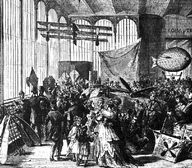
The great Aeronautical Exhibition of 1868. Note that
Stringfellow's triplane is prominently displayed. The design, particularly
the superposed wings, had a long-lasting influence on
aviation. |

Le Bris' improved glider. This is the first photo ever taken of a fixed -wing
aircraft. 
Stringfellow's unsuccessful but influential triplane. |
|
1870 |
Alphonse
Penaud, France, invents the "torsion motor, " using twisted
rubber bands to power miniature flying machines. This simple
invention is a boon to new science of aeronautics, providing
experimenters with a method to test and refine their
ideas without investing the time and expense to build
full-size aircraft. His first flying model is a variation on
an old toy, a miniature
helicopter. It’s copied by dozens of toymakers in Europe in America.
|
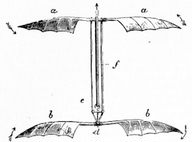
Penaud's rubber band-powered helicopter. A single
rubber band turned both propellers in opposite directions. |
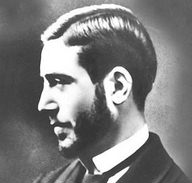
Alphonse Penaud.
|
|
1871 |
Alphonse
Penaud builds what he calls a
"planophore," a 20-inch long monoplane
with a pusher propeller powered by a rubber band. It flies 131 feet in 11 seconds —
the first flight of an inherently stable powered aircraft.
August 19 — Orville Wright
is
born in Dayton, Ohio.
Francis Herbert Wenham and John
Browning, England, invent the wind tunnel. They use it to prove that cambered
wings produce more lift than other shapes.
|
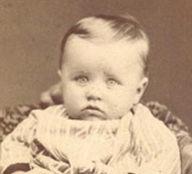
Orville Wright was the sixth child born to Milton and Susan Wright.
|
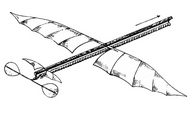
To provide longitudinal stability, the elevator surfaces of
Penauds "planaphore" were set at a slight negative angle of
attack to keep the nose up. The wings were set at a dihedral
angle to one another for lateral stability and to keep the
aircraft from rolling.
|
|
1873 |
Clement Ader,
France is an inventive electrical engineer who will soon
become one of the pioneers of the telephone industry. His
real passion, however, is aviation. He builds a bird-shaped
glider with goose-feathered wings, tethers the aircraft to
the ground, then lies prone upon the glider and lets it rise
to the limits of its ropes. He does not make free flights.
But the tethered ascents fill him with enthusiasm and he
spends the next 17 years developing a light-weight steam
engine and building a powered aircraft.
|
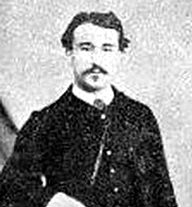
Clement Ader.
|
|
|
1874 |
Building on his successful
1857 design, Felix Du Temple and his
brother Louis create a man-carrying steam-powered monoplane
with a 40-foot (12-meter) wingspan and an innovative 6
horsepower engine of their own design. With a young French sailor
at the controls – he could regulate the angle of the tail and the rudder –
the aircraft rolls down an incline to a ski-jump and makes a brief hop.
But it hasn't enough power to sustain flight. Nonetheless it
was the first attempt at manned powered flight in a
fixed-wing airplane.
|

Du Temple's 1874 monoplane had several innovative
features. The wings were set at a dihedral angle and most of
the weight was forward for stability. The landing gear was
retractable and could be adjusted to change the angle of
attack during take-off. |
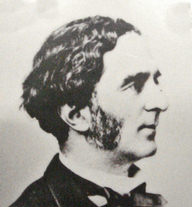
Felix du Temple.
|
|
1875 |
Thomas Moy demonstrates a large but unmanned "Aerial
Steamer" at the
Crystal Palace in London. It makes at least one flight in
which it lifts a short distance off the ground, an
impressive feat since it weighs 120 pounds (54 kilograms).
However, he is unable to secure funds to continue his
aviation experiments. He comments, "I do not expect my
countrymen to wake up to the importance of this subject
during my lifetime."
|
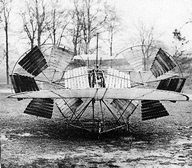
Moy's "Aerial Steamer."
|
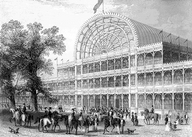
The cast-iron-and-glass Crystal Palace was Britain's showcase
until it burned in 1936.
|
|
1876 |
Building on the work of Marcus, Lenoir and others who are
experimenting with internal combustion engines, Nikolaus Otto invents
a powerful, efficient engine that runs on gasoline. The
secret of its efficiency is the four-part cycle on which it
operates. As the piston leaves the cylinder, it (1) draws in
vaporized fuel. It then re-enters the cylinder, (2)
compressing the vapor. (3) The vapor is ignited, forcing the
piston out of the cylinder again, then the piston (4) pushes
out the burned gases as it returns. This becomes known as
the Otto cycle or "suck-squeeze-bang-blow." |
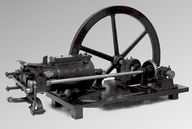
Otto's first four-cycle engine had a single cylinder. The
fuel was ignited when a door slid open at just the right
moment to expose the compressed vapors to a live flame.
|
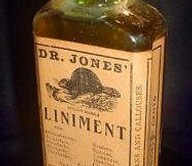
When Otto built his first engines, gasoline was sold by
apothecaries as a liniment.
|
|
1878 |
Bishop
Milton Wright, then living in Cedar Rapids, Iowa, brings home a Penaud-type helicopter for his sons.
They quickly wear out the fragile toy (which they refer to
as a "bat"), then begin to build their own copies. Caught
working on a bat at school when he should have been
studying, Orville
tells his teacher that he and his brother Wilbur plan to build a large enough
machine to carry the both of them into the air. But when they build a larger model, it
doesn’t fly. They won't understand why until much later in life. |
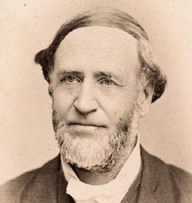
Bishop Milton Wright.
|
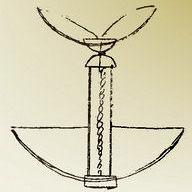
Orville drew this sketch of the "bat" in 1928.
|
|
1879 |
Victor Tatin
demonstrates a model monoplane for the French military at
Chalais-Meudon. The airplane has two tractor propellers
driven by a compressed-air engine. The fuselage, in fact, is
a tank that stores the air at a pressure of almost 300 psi
(20 ksc). The airplane takes off on its own, flies on a
tether around a circular track until the compressed air is
exhausted, then glides to smooth landing.
|
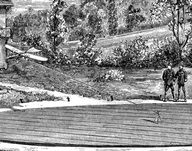
Testing Tatin's compressed air-powered model airplane.
|
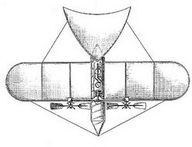
Top and side view of Tatin's airplane. Note the pressure
guage on top ot the fuselage/tank.
|